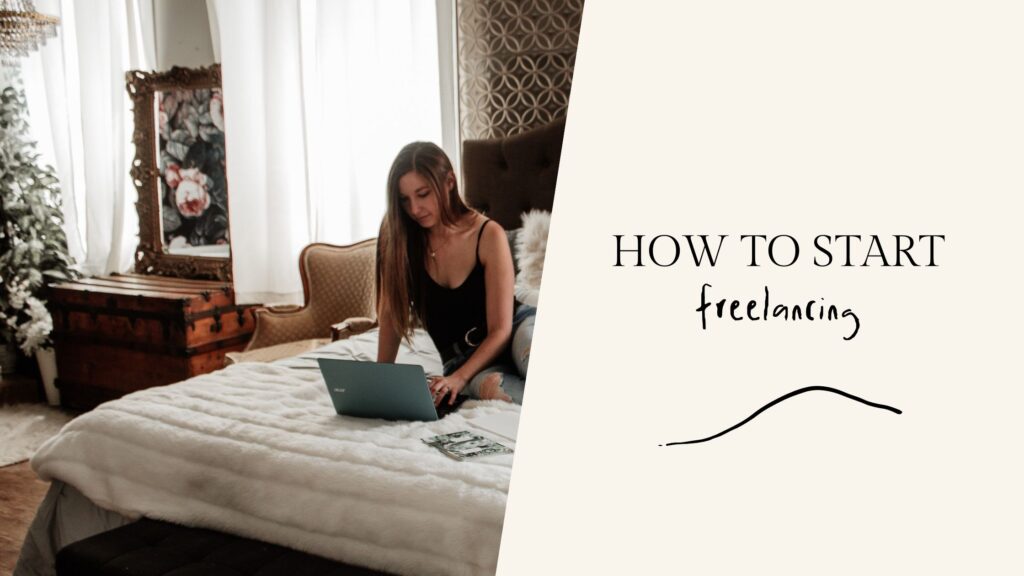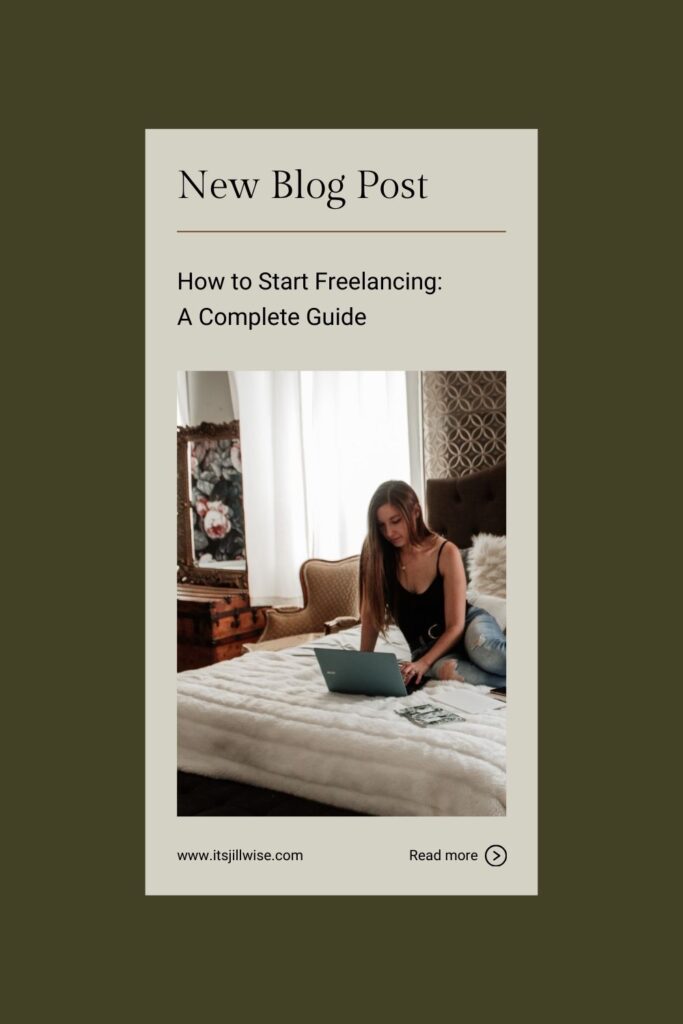How to start freelancing… Even if you have no experience
I’m so excited that you’re reading this blog post because that means you’re considering how to start freelancing. If you don’t know me, Hey! I’m Jill Wise, a freelance copywriter, brand strategist, and educator for freelancers. Through both my done-for-you copywriting studio and education platform, I’ve worked with, coached, and taught hundreds of others how to start freelancing and grow their business online.
This post is going to cover everything you need to know if you’re wondering how to start freelancing. And I have a handful of resources for you to build, grow, and scale a profitable and sustainable freelance business. Even if you have no experience or are getting started on the side of life… Because as a mom of littles, I get it!

Who am I to teach you how to start freelancing?
To start, I’ve been freelancing for a long time. When I first wrote this blog post, I was 6 years into freelancing. Now, I’m nearly a decade in at the time of updating this post (it was time for a refresh!). So I know a thing or two about how to start freelancing. And one of the top questions I get from my audience is: How did you start? This is a step-by-step look at how to start freelancing just like I did.
Disclaimer: Some of these details will vary based on your location. For example, I’ll reference the need to start charging sales tax (even as a sole proprietor or freelancer) if you’re Canadian like me. Even then, these thresholds vary by province. Consider this list an overview to get started on your own, not a perfect one-size-fits all because things will be different depending on where you’re located. But I think a freelance career is a great opportunity for continuous growth, welcomed daily challenges, and freedom.
With a bit of focused work, your freelance business will be up and running in no time.
How to start freelancing: Business setup
This phase in the process is what differs based on your location. Here’s the step-by-step of what I would do if I started a new freelance business today in my current location.
Choose a freelance business name
Choosing a business name is hard. I’m biased and like to keep these relatively simple because we pivot so much over the years that you don’t want to have to change your name every time you offer a new service. When I first started freelancing, I chose “Words by Jill” thinking that I would always focus on the words within my marketing offers. It turns out that was even wrong because now I do so much more than just write copy for clients. My business includes coaching, educational resources, and bigger picture marketing strategy… Not just copywriting.
If you have no idea what you want to offer yet, you can stick to your actual name (which you often don’t need to officially register the name of, just get a license to operate in your location). Or you could start with something generic like “X Studio” so it can grow with you.
Looking back, I wish I just went with my name from the beginning. Now that I officially operate under my name, I realize I could have saved myself the hassle of registering a business name separately. Especially as my business naturally grew to offer more than just copywriting words… It makes so much more sense for me to have a personal brand now, and I wish I did this sooner!
Register your freelance business
The next step is to get registered. I’ve lived and worked in multiple provinces across Canada, and the rules vary based on your location. In Ontario, I was advised to purchase a Master Business License to begin operating even as a freelancer. You can do this online, and it’s relatively simple. In Alberta, I needed to register the business name and get a local business license. In British Columbia, the process has been a little different to get settled here.
Most importantly, I registered my business with the CRA and made sure I had an appropriate sales tax number after passing the threshold within my province (and that of my clients). You need to know the threshold you need to pass to register for sales tax. Here’s more information on GST/HST in Canada. You likely won’t have to worry about this right away when you’re starting to freelance, but it’s good to know what you’re aiming for.
Claim your domain and handles
Claim your business name across the internet! After you’ve settled on a name, or decided that you’re going to build your business around a personal brand, you should claim the domain and social media handles for this ASAP. Even if you aren’t going to start freelancing and accepting clients immediately, you want to grab these before someone else does.
Open a business bank account when learning how to start freelancing
Even from the very beginning, your life will be so much easier if you kick off freelancing with a business bank account. I didn’t do this immediately and it was a headache to try to balance my books manually, noting which purchases and income was from my business versus my part-time serving job in the early days. In hindsight, I wish I took the extra step to separate my freelance business from my personal bank accounts sooner.
You may also want to open multiple bank accounts for your freelance business, not just a checking account. But savings for different areas of the business, etc. Many financial advisors often recommend this strategy as a way to keep track of all the money in and out, and available in your freelance business.
Invest in insurance for your freelance business
Even if you’re just learning how to start freelancing, you absolutely need to have insurance in place. Yes, it’s an extra cost of doing business. But it’s worth it. Especially as you grow your brand online.
These days, insurance providers are much better at understanding freelance businesses and often have recommendations for freelancers seeking insurance. Ask for general liability, and errors and omissions at least, but you may need more than that coverage. Having a good insurance policy will protect you from those worst-case situations. If you ever plan to work with larger companies, they may actually require that you have insurance. I know this isn’t mandatory for all countries though, so be sure to check with the rules of business locally for you.
Invest in bookkeeping and accounting software
Don’t delay choosing bookkeeping and accounting software. In the early days of when I was learning how to start freelancing, I manually tracked all my numbers via spreadsheets and an invoice template I found for Microsoft Excel… Yuck. It took so long to do everything, and I wish I invested in a proper bookkeeping platform sooner!
Eventually, I did invest in bookkeeping. I like QuickBooks Online because as I grew I could bring my bookkeeper and accountant on easily just by adding them as users. The smallest plan is good to start and you can always upgrade as needed. Now, all of this is manage by my bookkeeper, and we still use QuickBooks Online.
A note here is that these platforms do require a monthly fee, and transaction fees for your payment processor. Don’t bother trying to avoid these! It’s just a cost of doing business, and making it easy for your clients to pay you digitally is so much better than trying to find workarounds to avoid banking fees.
You can check out the other business tools I use here.
Do you need to incorporate?
This isn’t legal advice, but this is what I was told in the beginning: There’s no need to incorporate as a freelancer, and many people remain sole proprietors for their entire self-employed careers... Not just freelancers, but other business types as well. There are tax benefits to incorporating versus not, and often it just doesn’t make sense when you’re first learning how to start freelancing because you don’t have the larger revenue coming in that would allow you to reap any benefits of incorporating. On the other hand, incorporating will complicate your freelance business taxes, and other paperwork required.
Depending on factors like your annual revenue, tax bracket, personal goals, lifestyle, and more, you may eventually decide that it’s time to incorporate your freelance business.
It is, as I mentioned above, important that you have good business insurance in place to protect yourself as a sole proprietor.

How to start freelancing: Choosing service offerings
Maybe you know that you want to start working for yourself. But what services can you offer? There’s tons of ways you can start freelancing! Most digital creative fields offer the opportunity to work as a freelancer versus in house at a larger business or agency.
Examples of freelance service types:
- Graphic design
- Website design
- Freelance copywriting
- Content writing
- Social media marketing
- Ads management
- Public relations
- Journalism
- Photography
- Marketing
There’s also even more niche areas you can start freelancing in. For example, you could be a launch copywriter or a website copywriter versus a general copywriter. You could be a Pinterest manager and SEO specialist versus just a marketer.
Pick a niche for your freelance business
You don’t need to choose a niche in the traditional sense. Especially as you’re learning how to start freelancing, you may want to dabble between niches, and try different things before settling on what you really want to do.
Keep in mind that freelancers often grow faster when we choose a niche. In the beginning, your niche may change as you learn what you like to do most, but try to focus on just one area for a little while so you can truly know if it’s for you or not. A lot of business growth comes from choosing a direction and staying the course with intense tunnel vision so you can figure out if it will work or if you need to pivot.
However, choosing a niche doesn’t mean you have to choose a specific industry. For example, in the early days of freelancing, I said that I was a copywriter for creative businesses. That included a variety of industries: graphic designers, virtual assistants, photographers, influencers, speakers, etc. From there, I got more specific about a type of person… Meaning their actual personality. Then their industry mattered even less. I also started teach other creative businesses how to write copy that sells the value of their services without feeling salesy or gross. Then narrowed this teaching to focus mainly on other freelancers, marketers, and personal brands.
I wrote a blog about picking a niche, and you can read it here.
How to start freelancing: Develop your first offers
Now that we’ve talked about the technical side of how to start freelancing, what about the rest of the business? Obviously, you need to decide what services you want to offer, and develop your first offers.
The good news: Nothing is permanent. You can pick a service offering now and change your mind later! Just being careful to not change too often, otherwise you’ll confuse those who are interested in working with you.
How do you decide what to offer? Answer this question: What do people need? Listen closely and begin to develop a single offer that you can start to sell first. Be careful when setting your rates though! You want to price yourself according to your own experience, skills, and the market. Often when we’re new to freelancing, we feel like we need to price our services really low, but undercharging is actually bad for everyone. A quick Google search can tell you the going rate for a specific service. You can also ask in lots of Facebook online business groups what others charge for their packages, which will help you identify a good starting point.
If you want to learn more about how to find your first few clients online, I wrote a blog post about how to find clients for your creative business.

How to start freelancing: Get clients
Alright, so if you’re ready to start selling your first offer and find your first client, you need to consider the channels that you will reach those dream clients through.
Personally, I prefer to focus on inbound lead generation strategies, like having a solid inbound sales pipeline. I hate cold pitching! And while I always had luck with in-person networking events in the early days, I didn’t really enjoy it. I prefer to create content and fill the top of my inbound sales pipeline with traffic, so that’s where I paid the most attention when learning how to start freelancing and landing clients.
How to start freelancing with a website
Regardless of which method you choose to start freelancing and get clients, you need a website. You need a home base to send leads to that shows what it’s like to work with you and guides them to the next step. Your website is your piece of the internet where you get to share your offers, expertise, and results with dream clients.
If you need help with your website copy, there’s a template in The Biz Bar that other freelancers love (even other copywriters) because it’s really easy to use! Just plug-and-play with your own words in the wireframed templates. Learn more about the website copy template library here.
How to start freelancing with no audience
How do you start getting traffic to your website? You need an audience. But that audience doesn’t need to be that big! I started getting inbound leads with almost no online presence. I had 300 Instagram followers when I got my first inbound lead.
To get started, choose which social media channels you think will promise the highest return on your invested time. Where do your dream clients hang out? Start there. Don’t stretch yourself too thin. Don’t worry about paid advertising as a freelancer. Just get started with something.
How to start freelancing and get local clients
Don’t forget the importance of in person networking and overall hustling to get those first clients. I landed my first 5-figure gig from meeting the right person at the right networking event. You never know who you might have the opportunity to talk to! My biggest advice here though is to go in with the goal of creating connections, not landing clients. People can tell if you’re being pushy or salesy, and it won’t work out in your favour.
How to start freelancing with cold pitching
Don’t be afraid to cold pitch people and businesses that you’d absolutely love to work with. With the right pitch, you just might get the job! I landed my first freelance writing gigs with cold pitches, and kept pitching to bigger and bigger brands that I wanted to work with.
Full transparency: Be prepared to feel rejected in these early stages. You’ll get better at sales over time and the rejections will become fewer between. But it was definitely emotional at times, and ultimately that’s why I decided to focus on my inbound lead generation strategy versus cold pitching for every gig. Some people like cold pitching! I am not one of those people.
How to start freelancing: Grow with authority
After you have a few clients under you belt, you will want to start growing and scaling your freelance business. The best way to do this is by focusing on the results that you provide clients. Gather testimonials, develop case studies, and use these to build your authority online.
Other ways to build authority are by focusing on growing your online presence as a thought leader. I chose Instagram at first because I knew my dream clients were hanging out on the app. Once I had a good understanding of that platform, I added my blog, email list, and Pinterest into the mix. YouTube was a more recent addition. Sometimes I dabble on LinkedIn too.
You could also do guest posts and guest spots on podcasts and webinars, showing up in other paid communities, and just trying to show that you know what you’re talking about.
Most importantly, the results you get for others will always speak louder than the content you create.
Grow and scale your freelance business
After you have consistent clients coming in, are starting to grow your authority online, and are generally doing okay as a freelancer… You may be looking for ways to continue to grow and scale your freelance business. I teach and consult on 3 core pillars for freelancers:
- Services Suite / Offers and Pricing: Restructuring your core offers to trim the fat and set your business up to scale. This could be through digital products, a premium service, or an agency model… Or a combination approach.
- Brand Positioning and Messaging: Elevate the perception of you and your brand online, so you can attract and convert better, more aligned leads that are willing to pay premium prices for your offers.
- Processes and Reclaiming Space: Refine the structure of your business, including how you and your (potentially future) team operate day-to-day to maximize impact. For many, this includes working less, but making more.
The above pillars guide my mastermind program for freelancers. Learn more about The Inner Circle here.
Create an exit strategy to go full-time freelance
I was lucky and never had a real 9 to 5, so I’ve never felt that struggle… I don’t think I’m very employable because I’ve always done my own thing! However, I did serve for a long time while in school and growing my business. When I knew I was mentally ready to quit, I created an exit strategy that would ensure I could comfortably quit this job to go full-time freelance. Your plan will look different for you, but here’s a few aspects to consider:
- How many clients do you need to have to replace your full-time job income? Remember things like expenses and saving for income tax! Revenue earned is not the same as your take-home income.
- How many clients do you need to land or offers do you need to sell to meet that revenue goal?
- How many hours do you want to work each week in order to achieve the above?
- How much have you saved as a buffer in case you don’t have clients coming in consistently?
The saving bit is really important to most. I had saved enough that I knew if I couldn’t find ANY clients and all my existing ones quit on me, I could still survive for 6 months with no problems. Some people are happy with just a month or two, but I like to lean on the safer side whenever doing something new.
Prioritize continuous learning as a freelancer
Continuous learning is so important for freelancers, especially in the online space. We always need to be aware of the latest trends and one step ahead in order to stand out. If you’ve made it this far, you might like 4 Steps to Profit. This free guide will walk you through the foundations of setting up a sustainable and profitable freelance business… One that’s grown based on inbound leads versus cold pitching.

Related
Leave a Reply Cancel reply
Leave your info below to join. You'll be added to my email list, but can opt out at any time.
